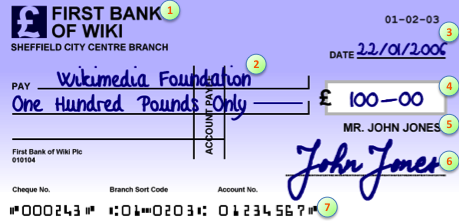Cheque writing is not as popular as it used to be. These days you can do a lot via online banking. Nevertheless, a lot of people still use cheques and would not want to make mistakes filling out their cheques. This is a guide on how to write a cheque properly in the uk. Please note that your bank may not honour your cheque if you do not write it properly.
Parts of a cheque
As part of the process of learning how to write a cheque properly, let us consider the parts of a typical cheque. The image of the cheque above is from a fictitious bank. The cheque is crossed, which means that the payee or recipient of the cheque should be the cheque into their bank account instead of collecting the cash over the counter.
- Name of the Bank – First Bank of Wiki is the name of the bank where your money is kept. The is the bank that will transfer your money to the account of the recipient of your cheque. This bank is also known in technical terms as the drawee.
- Recipient of the cheque or Payee – This is the name of the person or business who is to receive payment.
- Date – This is the date on which you write the cheque. It could also be the date on which you want the payee to present the cheque at the bank. The date of presentation may not be the same as the date on which you are writing the cheque. A cheque that you write so that the recipient presents it at his or her bank on a future date is called a post-dated cheque.
- Amount in numbers
- Name of Account Owner – Also known as Drawer
- Signature of the Account holder
- Bank Account Details.
Some tips on How to write a cheque
Now that we have listed the different parts of a cheque, I would like to present some tips on how to write out the different parts of the cheque.
What type of Pen? – How to Write a Cheque.
When writing a cheque, please always use a pen. You do not want to use a pencil or a pen with erasable pen. Try always to use a black or blue ball Pen. Do your best to ensure that you do not make any mistakes while writing the cheque. This is so because if you make a mistake, then you will have to rewrite the cheque or initial the cheque to show that you are aware of the cost implication.
Name of Payee – How to write a cheque
When writing the name of a payee on your cheque book, please make sure you spell their name correctly as it is written at their bank. When writing a cheque to a company or business, make sure you get the exact spelling of the company name. You can usually find these in your invoice or similar statements
Date – How to write a cheque
Usually all you have to do is enter the date on which you are writing the cheque. On some cheques you just have to fill in the numbers because boxes have been prepared for the date. If your cheque book is like this, then in makes things easy for you. Remember you may choose to post date your cheque.
Amount in words – How to write a cheque
Write out the full amount that you want the bank to pay to your payee. After writing the full amount make sure you put the words pounds and only after the amount. This will help ensure that no one can add any number to your amount and withdraw much more.
Example
Three hundred and fifty and 45/100 pounds.
Amount in Numbers – How to write a cheque
Write the amount you want to pay to your payee. When writing whole numbers make sure you add 00 cents at the end. This will prevent other people from adding some numbers and therefore drawing all your savings. Here are some examples
- 2344.00
- 3481.00
- 34.67
- 0.23
Signature of the Account Holder – How to write a cheque
Please write the signature that your bank has. Some banks are very picky. They may choose not to honour a cheque when the signatures are not similar enough.
